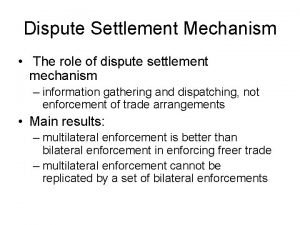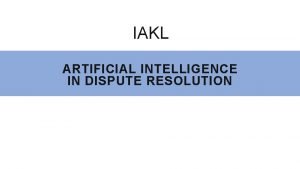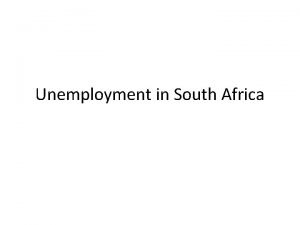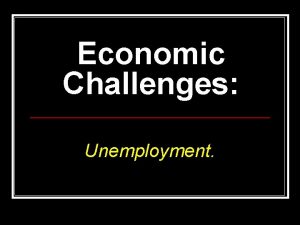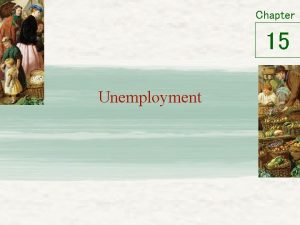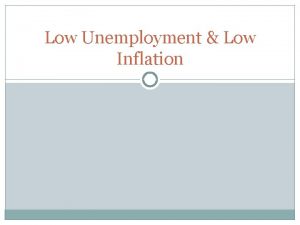Unemployment in South Africa Descriptors Determinants International Dispute

























- Slides: 25

Unemployment in South Africa Descriptors & Determinants International Dispute Resolution Agencies’ Conference Mount Nelson Hotel, Cape Town 22 -25 th October HAROON BHORAT School of Economics & Development Policy Research Unit, University of Cape Town E-mail: haroon. bhorat@uct. ac. za Website: www. commerce. uct. ac. za/dpru/

OVERVIEW A Descriptive and Econometric Overview Causes of Unemployment in South Africa: A Line-Up of the Usual Suspects A Menu of Possible Interventions

• Population: 40. 2 million • Life Expectancy at birth: 47. 7 • GDP (current prices): $255 bill. • GNI per capita: $5390 • Merch. Trade (% of GDP): 47. 1 • Total Debt Service: 6. 9 • Internet users: 108. 8 per 1000

Unemployment Rates Around the World Source: ILO (2007)

Unemployment In South Africa: The First Decade of Democracy National Unemployment Rate: 1995 -2005 Unemployed numbered approximately 7. 8 million individuals in 2005 Discouraged work seekers constitute 42% of broadly unemployed Data Quality & Reliability.

Unemployment Rates In South Africa: Race & Gender 53% 47%

Unemployment Rates In South Africa: Age Distribution 34%

Youth Unemployment Rates: The Global Context Source: KILM, 2007

Unemployment Rates by Education Level

Unemployment: Multivariate Independent Variable Analysis d. F/dx Std. Err. z Coloured 0. 082 0. 013748 5. 70 Asian 0. 220 0. 0167439 9. 76 White 0. 304 0. 0102678 18. 26 Female -0. 114 0. 0080705 -14. 06 25 -34 years -0. 007 0. 0249169 -0. 26 35 -44 years 0. 129 0. 0224165 5. 42 45 -54 years 0. 232 0. 016194 11. 81 55 -65 years 0. 341 0. 0060921 28. 91 No education to Incomplete GET -0. 003 0. 0018769 -1. 61 Complete GET -0. 011 0. 0042696 -2. 59 Complete High School 0. 017 0. 0130646 1. 28 Diploma 0. 212 0. 0126801 13. 62 University Degree 0. 065 0. 0200266 3. 21 Metro -0. 016 0. 0090603 -1. 77 Lambda -0. 345 0. 0356939 -9. 67

The Markers of Unemployment in South Africa Race, Gender, Age, Location & Schooling serve as the key attributes defining and explaining broad and narrow unemployment rates in South Africa. The failure of the schooling system & in part, the further education & training System (FET) is particularly important for policy formulation. Differentiating between the unemployed and the unemployable.

Two Worrying Footnotes: 1 The Legacy of Apartheid Schooling Variable/For mer Department High School Pass Rate Pupil. Teacher Ratio Schools with User Fees African White 48. 39 95. 14 31. 04 23. 72 0. 20 0. 92 A bifurcated schooling system, where disadvantage is still located within former African Schools Management of schools; knowledge infrastructure; Teacher Quality

Two Worrying Footnotes: 2 The Composition of Graduate Unemployment 200, 000 (3%) of all Ue are ‘graduates’ (up from 2% in 1995) Only 18% of unemployed graduates have degrees: Clearly the bulk of the problem is with diplomas and certificates

Possible Causes of Unemployment in South Africa Output & Employment LFP Growth Rates Labour Demand-Supply Mismatch Wages and Employment The Role of Trade Unions & Bargaining Councils The Nature of Economic Growth

Output and Employment Simple GDP Elasticity of Total Employment Annual Percentage Change in: Total Employment GDP Elasticity 1990 -1995 0. 13 0. 8 0. 16 1995 -2005 2. 60 3. 27 0. 80 No Evidence for Jobless Growth Thesis For Given Level of Growth, Employment Expansion Adequate The Nature of the Growth Path…. .

Output-Employment Elasticity: Comparable Measures Source: KILM, 2007

Post-Apartheid Labour Supply Trends Category 1995 (Oct) (‘ 000 s) 2005 (Sep) (‘ 000 s) Change Absolute (‘ 000 s) Target Growth Rate Employment Absorption Rate Percent Broad Definition Estimates Employment 9 515 12301 2786 29. 28 4 239 7800 3561 84. 01 13 754 20100 6346 46. 14 Unemployment (broad) Labour Force 66. 69 43. 90

Skills-Biased Employment Growth: 1 Skilled Employment: Share increased from 9 to 11% Semi-skilled Employment: Share increased from 59 to 61% Unskilled Employment: Share declined from 31 to 27%

Skills-Biased Employment Growth: 2 Industry-Based Relative Demand Shift Between- and Share of Measured by Occupation, 1995 Betwe within-sector shifts Within Total within in en Total 2005 estimates for 1995 Manager 1. 28 18. 24 19. 52 93. 46 -2005: SBTC Professional 1. 42 7. 50 8. 92 84. 08 evident. Clerical 2. 43 14. 66 17. 09 85. 78 Service 2. 24 14. 34 16. 58 86. 50 The nature & Agric. -0. 17 -17. 23 -17. 40 99. 00 trajectory of labour Craft demand results in 2. 39 14. 68 17. 08 85. 99 Oper. & A the co-existence of 0. 73 5. 20 5. 93 87. 62 an excess supply of Elementary. -0. 13 -0. 53 -0. 66 80. 37 Domestic labour with a Workers 1. 48 10. 16 11. 64 87. 26 chronic skills shortage in the

Wages & Employment Wage-Employment Elasticities by Main Sector, 1990 -1998 Sector & 1990 -93 1994 -98 Mining & Quarrying -0. 19 -0. 96* Manufacturing -0. 06 -0. 45* Construction -0. 49* -0. 63* Utilities -0. 02 -0. 03 -0. 13 0. 50* -0. 1 -0. 22 0. 20* -0. 01 Commerce, Catering Accommodation Transport & Communication Financial Services Community, Social & 0. 05 Personal Services -0. 50* Private Sector Total -0. 53** -0. 35** Elasticity value not unusual for developing country estimates Translate into, ceteris parabus, an argument for wage adjustments? Source: Fields et al. 1999

Trade Unions & Bargaining Councils Union-Wage Premia in the SA Labour Market, 2005 Dependent Variable: Log of Monthly Earnings Quantile: OLS 0. 1 0. 25 0. 75 0. 9 Private Sector BC Member 0. 03 0. 05 0. 01 0. 02 -0. 01 Public Sector BC Member 0. 28* 0. 32* 0. 33* 0. 26* 0. 19* Union 0. 23* 0. 35* 0. 31* 0. 27* 0. 21* 0. 15* Union-wage premia very high by international standards Role of bargaining councils (and renewed power of public sector BC) not to be under-

Trade Unions & Bargaining Councils

Looking Ahead: Pro-Poor Growth? Growth path in the 1995 -2000 period biased against the poor State Transfers in post-2000 period assist in spreading gains from growth

Pro-Poor Growth and the Informal Economy

Unemployment in South Africa: Possible Solutions Fix the Higher Education System to Focus on Narrowing Gap Between Supply & Demand Improve Employment Placement (Information Asymmetries) A dual (youth/non-youth) labour market A Youth Cadet Service for the Public Sector Ø Picking Winners in the Schooling System
 South africa unemployment rate by race
South africa unemployment rate by race Labour act india
Labour act india Krishna godavari dispute
Krishna godavari dispute Objectives of industrial dispute act 1947
Objectives of industrial dispute act 1947 Msc construction law and dispute resolution
Msc construction law and dispute resolution Wto dispute settlement mechanism
Wto dispute settlement mechanism Dispute settlement mechanism meaning
Dispute settlement mechanism meaning Right dispute
Right dispute Objectives of industrial dispute act 1947
Objectives of industrial dispute act 1947 Maine canada border dispute
Maine canada border dispute Btec applied law
Btec applied law Relic boundary example
Relic boundary example Financial education services compensation plan
Financial education services compensation plan Consequent boundary definition ap human geography
Consequent boundary definition ap human geography Csa basic thresholds
Csa basic thresholds Phyrrho investments it s an english predictive coding case
Phyrrho investments it s an english predictive coding case Delay and dispute mitigation
Delay and dispute mitigation Dispute management in accounts receivables
Dispute management in accounts receivables Dispute management in order to cash
Dispute management in order to cash Agrement south africa
Agrement south africa Herbalife levels and income
Herbalife levels and income Dr. hamilton naki
Dr. hamilton naki Unjust enrichment latin
Unjust enrichment latin Political map of north africa and southwest asia
Political map of north africa and southwest asia 11 official languages of south africa
11 official languages of south africa Was south africa a dutch colony
Was south africa a dutch colony






